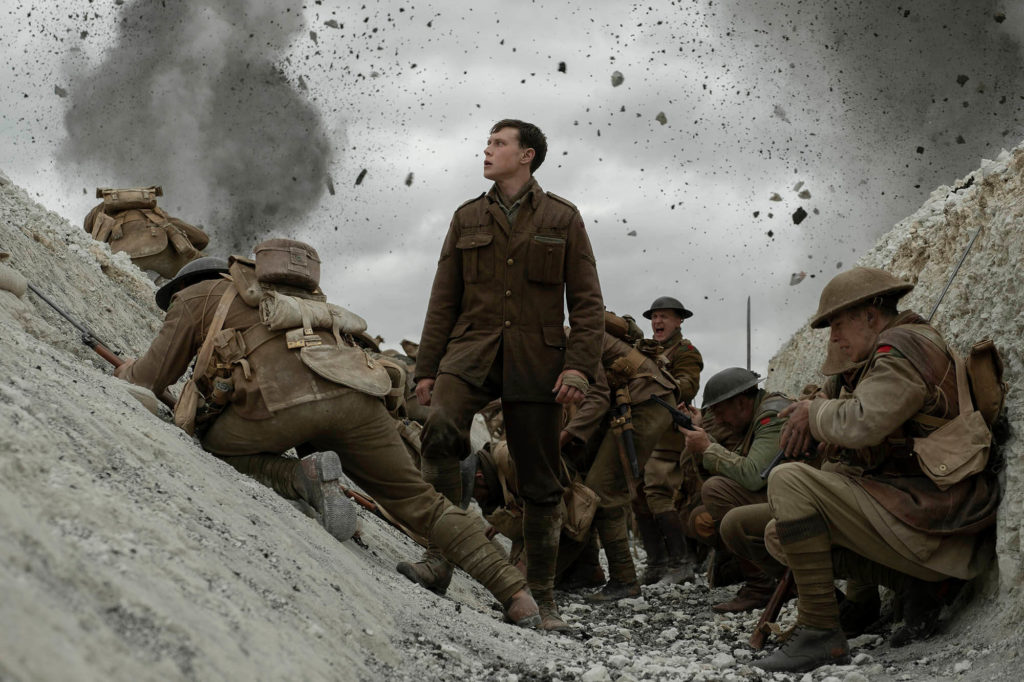By Pete Villasmil
Directed by Sam Mendes
Starring: Dean-Charles Chapman, George Mackay
Ambitious. If there is a word that describes 1917, it’s ambitious. Not only in the sense of trying to provide a compelling war drama, in a crowded genre that already holds such iconic classics like Saving Private Ryan and Apocalypse Now, but also in attempting to deliver a novel approach to crafting such epics. It’s a tall order that the film sets out to achieve, but the reality is 1917 engages in a valiant effort to do this, and succeeds on all fronts.
Taking place in its titular year, 1917 portrays the story of two young soldiers at the height of World War I. Tasked with delivering an urgent message to another battalion, Lance Corporal Blake (played by Dean-Charles Chapman) and Lance Corporal Schofield (played by George Mackay) set off on a perilous mission to hopefully save the lives of hundreds.
It would be fair to presume that the premise is simplistic or unoriginal, especially considering that countless other war films have utilized a similar dilemma to kick off their stories. This characterization is thankfully invalid as 1917 makes it clear from the onset that the story is more about the journey and the experience rather than delivering a complex narrative. Some may be wary, or even disappointed with the lack of a sophisticated, multi-faceted plot, but rest assured 1917 benefits from keeping things simple. That’s not to say that the film is straightforward or predictable by any means, far from it in fact. 1917 engages and immerses its audience in such a manner that it would be a crime to even label the film as anything less than engrossing.
This is certainly true because of the film’s biggest selling point. 1917 is edited to seem like it was filmed in one long take, essentially meaning there are no visible cuts in the film and the camera is always in motion. This technical element affects almost every component of the movie. While this technique may seem like a gimmick more than anything else, director Sam Mendes and cinematographer Roger Deakins pull it off masterfully. Because of the appearance of a continuous shot, the audience gets immersed in a way few movies can even dream of doing because of the staggering amount of detail the technique is able to capture on film. As the protagonists progress on the journey, you feel as if you’re right beside them. This effect builds more tension than one would expect, as danger could always lie outside the camera’s view. Whether its Schofield and Blake passing through rat infested trenches or exploring a treacherous mineshaft, Mendes goes to great lengths to ensure that the audience is there every step of the way. Even smaller details, like decaying corpses of horses in a battlefield or massive shell casings in an abandoned military camp, are meaningful additions that contribute to the experience. The tremendous effect these minute environmental features have is a testament to the brilliance of the set design is. 1917’s action sequences are not just exhilarating, but also one of a kind because of the continuous shot. There’s a uniquely satisfying momentum these scenes have that truly puts the film’s scope into perspective, especially in scenes that feature massive armies facing off in combat.

The icing on the cake is that the movie simply looks stunning . Deakins proves why he’s one of the best cinematographers working today as he captures gorgeous shots of the brutality of war. A scene in the third act involving a burning building illuminating a dilapidated city is particularly striking, as threatening silhouettes of enemy soldiers rest on the horizon. As a whole, the forward-thinking cinematography is remarkable and establishes 1917 as a technical cinematic achievement.
The performances are just as impressive. Despite featuring some of the UK’s best talents like Colin Firth and Benedict Cumberbatch in supporting roles, 1917’s two leads are able to maintain a strong presence on screen and deliver a passionate performances. Chapman commits to a vulnerable portrayal of Lance Corporal Blake, bringing the character’s weakness to the forefront, a facet of the character that is tantamount to the film’s central conflict. However, Mackay’s work in this film is not only impressive, but career defining. His powerful performance spotlights the intensity of war along with an infectious sense of determination that invites the audience to emotionally invest in his survival story.
Thomas Newman heightens the film’s most intense segments with a thunderous score. Even in calmer periods, Newman finds a subtle way to organically weave his music into scenarios, providing a dramatic touch to some of 1917’s most poignant and compelling moments.
Sam Mendes’ passion project is simply a triumph. As the world enters a new decade, 1917 has set a high standard for movies in the coming years. It is a technical achievement that will no doubt influence cinema for years to come. It is the type of movie you would expect to come out in 2020. Even with a simple premise, the film is able to defy expectations and provide an experience that lingers in the viewer’s mind. Exhilarating and breathtaking, 1917 easily earns its spot as not only one of the best of this new decade, but one of the best in its genre.
*Tremendous Trivia: In the Academy’s 92 year history, 1917 is the only Best Picture Nominee to have a fully numerical title.*


Great article Pete, I lived the movie and enjoyed your perspective very much
Thank you! I truly appreciate it!
I absolutely loved this movie. You really captured some of the key elements and make me want to see it again.
Glad you enjoyed it!